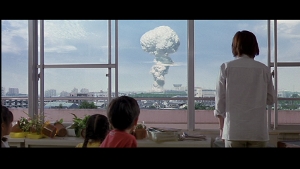 Like most middle-aged men, Godzilla suffers from a deplorable excess of emotional baggage. After fifty years of high highs and low lows his identity has become erratic. Toho, Godzilla’s production company, is currently scrambling to field the movie that will return Godzilla to his rightful place as champion of the giant monster action extravaganza.
Like most middle-aged men, Godzilla suffers from a deplorable excess of emotional baggage. After fifty years of high highs and low lows his identity has become erratic. Toho, Godzilla’s production company, is currently scrambling to field the movie that will return Godzilla to his rightful place as champion of the giant monster action extravaganza.
The Lizard King fall from grace began during his “hiatus” from ’95-’98. This gave the Gamera trilogy time to come along and redefine the boundaries of good Giant Monster Cinema (believe it, or not). The trilogy did this in many ways…which I rattled on about ad nausem in my review of Gamera 3. But most importantly (and I’m sure Toho’s executives would agree) the trilogy raked in an absolute shitload of money.
Never one to miss a wave, Toho revived the King of the Monsters for Godzilla: 2000. And the fans…kinda shrugged, really. I mean, sure, it was Godzilla, but…you can read the review yourself.
After the maudlin performance of the above and its non-sequel, Godzilla vs. Megaguirus, Toho went looking for the knockout punch. What better way to end all this silly talk of Gamera than to hire Gamera‘s director, Shusuke Kaneko?
What better way, indeed?
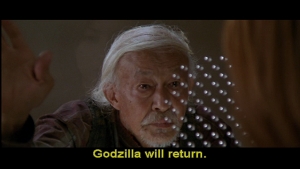 Bowing to the New Standard, this movie takes place in yet another wacky parallel dimension. Events from the first Godzilla movie are referenced…but that was fifty years ago. Japan has moved on, enjoying an era of unparalleled success, and many in “the younger generation” consider Godzilla a myth. Some old wive’s tale what with to scare the yung’ins. As our film’s Mysterious Old Man points out, Japan has forgotten the crimes of its past and its young people have all become venal, giggly, puppy-killing materialists. (No, really…Mothra even breaks up an instance of youthful puppy-killing early in the picture.)
Bowing to the New Standard, this movie takes place in yet another wacky parallel dimension. Events from the first Godzilla movie are referenced…but that was fifty years ago. Japan has moved on, enjoying an era of unparalleled success, and many in “the younger generation” consider Godzilla a myth. Some old wive’s tale what with to scare the yung’ins. As our film’s Mysterious Old Man points out, Japan has forgotten the crimes of its past and its young people have all become venal, giggly, puppy-killing materialists. (No, really…Mothra even breaks up an instance of youthful puppy-killing early in the picture.)
In the culture which mass produced ancestor worship, this is a cardinal sin…so its no surprise when monsters begin to appear all over the world (including “that one in New York”*), bringing their own special brand of urban renewal. JSDF Admiral Tachibana (Ryudo Uzaki) warns his underlings that an attack on the Japanese mainland could be eminent.
*[Military Guy #1: Was it really Godzilla? Military Guy #2: The Americans said it was Godzilla, but our guys have some doubts.]
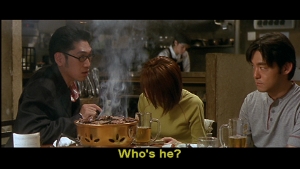 Cut to Yuri Tachibana (Chiharu Niyama), Admiral Tachibana’s daughter and your Reporter for the remainder of the film. And I’m thinking, Hell, all we need is a Scientist and we’ll have the full deck. Enter Yuri’s (apparently platonic) friend, Science writer Teruaki Takeda (Masahiro Kobayashi), though he never does anything very scientific. Instead, Mr. Science Writer with appear and disappear at strategic plot points throughout, usually to lend a nerd’s credence to the supernatural goings on. They’ll certainly be a lot of them, since, Yuri hosts the low-budget, Sightings rip-off, Digital Q. Soon after we meet her, Yuri stumbles upon a Mysterious Old Man whilst on assignment in the woods of Mount Myoko (in Niigata Prefecture). The wandering, elderly forest-dweller informs her that Godzilla will indeed return, and soon. Only Japan’s three Guardian Monsters stand any chance of stopping him.
Cut to Yuri Tachibana (Chiharu Niyama), Admiral Tachibana’s daughter and your Reporter for the remainder of the film. And I’m thinking, Hell, all we need is a Scientist and we’ll have the full deck. Enter Yuri’s (apparently platonic) friend, Science writer Teruaki Takeda (Masahiro Kobayashi), though he never does anything very scientific. Instead, Mr. Science Writer with appear and disappear at strategic plot points throughout, usually to lend a nerd’s credence to the supernatural goings on. They’ll certainly be a lot of them, since, Yuri hosts the low-budget, Sightings rip-off, Digital Q. Soon after we meet her, Yuri stumbles upon a Mysterious Old Man whilst on assignment in the woods of Mount Myoko (in Niigata Prefecture). The wandering, elderly forest-dweller informs her that Godzilla will indeed return, and soon. Only Japan’s three Guardian Monsters stand any chance of stopping him.
Sure enough, after forty minutes of watching our characters stumble around setting things up, the Big G makes his presence known, cutting a swath of destruction through the countryside. Soon, Baragon (last seen in the Toho classic Frankenstein Conquers the World), Mothra (on lone from her own failing, kiddiewink movie series), and King Ghidorah, rise to meet him. And the mash begins.
GMK has plenty to offer. But for all its mystical jibber-jabber and digitally-enhanced, man-in-suit special effects, the movie falls short of its illustrious predecessors. Reports of this being the next Godzilla vs. King Ghidorah (1992) are greatly exaggerated…but, then again, so is that film’s reputation.
 Plotwise, GMK is much more in line with Godzilla’s adventures of the early 60s. The G-man is once again a spectre of Ultimate Evil: an impersonal, fearsome creature who exists to punish Japan for its past (and present) sins. All well and good…if it weren’t for the fact that we’ve been cheering the Big Guy on for the last fifty years. Suddenly I find myself in a completely upside-down world, forced to root for King Ghidorah of all creatures. (Not that His Three-Headed Highness does much more than die. Repeatedly.) There’s something fundamentally wrong about rooting for Godzilla’s most popular “villain”…even though one could argue I’m doing that any way whenever I root for Godzilla himself.
Plotwise, GMK is much more in line with Godzilla’s adventures of the early 60s. The G-man is once again a spectre of Ultimate Evil: an impersonal, fearsome creature who exists to punish Japan for its past (and present) sins. All well and good…if it weren’t for the fact that we’ve been cheering the Big Guy on for the last fifty years. Suddenly I find myself in a completely upside-down world, forced to root for King Ghidorah of all creatures. (Not that His Three-Headed Highness does much more than die. Repeatedly.) There’s something fundamentally wrong about rooting for Godzilla’s most popular “villain”…even though one could argue I’m doing that any way whenever I root for Godzilla himself.
I mean, Gamera’s a bad ass and all…but Godzilla invented the role of Giant Monster Anti-Hero. What’s more, Godzilla’s plasticity allows him to take this role into much darker territory than Gamera. The Big G routinely goes places giant turtles fear to tread for very good, focus group-tested reasons. Kaneko’s already displayed the stones necessary to tell such a story, provided he has a decent script to work worth. That film might’ve been interesting, entertaining, and maybe even original…three things GMK completely fails to be.
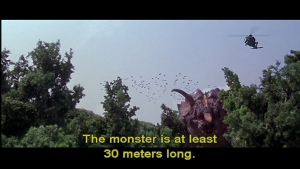 Frankly, I expected more from Kaneko. On one level, GMK is a missed opportunity. Another well-intentioned misfire from our friends at Toho. Still, the sheer glut of monster action makes it worth owning. The fights are numerous, well-executed, and brutal in an animalistic way rarely seen before in Godzilla’s films. (A little more blood wouldn’t have hurt…but, never mind that personal aside.) No more of that “ray trading” nonsense from the early 90s. No surprise Godzilla is the fightin’est monster in the film, being, after all, the Antagonist. But I’ll give props to the Guardian Monsters even though the film itself doesn’t. The picture’s focus automatically shifts to Godzilla once he appears. When he’s portrayed as the hero-by-default, this is fine. But with Godzilla as the Enemy of Mankind, it falls on the other monsters to gain our sympathy…or, at the very least, our attention. Mothra, Baragon and Ghidorah never do, since they’re never anything more than supporting players. As protagonists, this forces them to be as one-dimensional and overly simplistic as our human characters. The three Guardians could’ve been giant robots piloted by 14-year-old kids and it wouldn’t have made a difference. Might’ve even improved the film. Certainly would’ve given us a more interesting human cast.
Frankly, I expected more from Kaneko. On one level, GMK is a missed opportunity. Another well-intentioned misfire from our friends at Toho. Still, the sheer glut of monster action makes it worth owning. The fights are numerous, well-executed, and brutal in an animalistic way rarely seen before in Godzilla’s films. (A little more blood wouldn’t have hurt…but, never mind that personal aside.) No more of that “ray trading” nonsense from the early 90s. No surprise Godzilla is the fightin’est monster in the film, being, after all, the Antagonist. But I’ll give props to the Guardian Monsters even though the film itself doesn’t. The picture’s focus automatically shifts to Godzilla once he appears. When he’s portrayed as the hero-by-default, this is fine. But with Godzilla as the Enemy of Mankind, it falls on the other monsters to gain our sympathy…or, at the very least, our attention. Mothra, Baragon and Ghidorah never do, since they’re never anything more than supporting players. As protagonists, this forces them to be as one-dimensional and overly simplistic as our human characters. The three Guardians could’ve been giant robots piloted by 14-year-old kids and it wouldn’t have made a difference. Might’ve even improved the film. Certainly would’ve given us a more interesting human cast.
I mean, just look at them. Everybody’s here. And they all brought their cliched character arcs with them. I keep coming back to Gamera, but seriously…I’ve found it’s much nicer when the human characters take an active role in these world-shaping events. I have a license to sit back and watch the fight scenes…I’m a completely independent observer. There’s no reason these characters should waste so much time staring into monitors and shooting things with TV cameras, even if we they are reporters. Take charge of your fate, you stupid bastards. Don’t wait until the final action sequence, the way Admiral Yuri’s Dad does. Not only will I be tired of your blathering by then, I’ll view your coming to terms with your attractive, oddly-celebrate, and occasionally-drunk daughter as a horribly rude interruption.
 Maybe the rampant TV-watching is meant to be some form of commentary on Man’s increasing detachment from the world in the face of twenty-first century technology. (We even hear the famous last lines:”Our forces are now equipped with weapons that are far more advanced than anything we had before!”) Or maybe I’m just putting a lot more thought into this than GMK‘s three screenwriters. They certainly didn’t bother to consider what suicidal urge drives Yuri to chase Godzilla around on a bicycle…or contrive a believable way for her (and her Science Writer) to survive the two-on-one Final Battle between our titular monsters. We’re meant to believe that not only is Yuri the ballsiest fake-journalist in all of Japan, she’s also neigh-invulnerable, surviving everything from massive explosions to falls from Yokohama’s scenic bridges. Maybe all that radiation exposure gave her powers and abilities far beyond those of mortal reporters while we were distracted with the monster rasslin’. It’s either that, or cancer.
Maybe the rampant TV-watching is meant to be some form of commentary on Man’s increasing detachment from the world in the face of twenty-first century technology. (We even hear the famous last lines:”Our forces are now equipped with weapons that are far more advanced than anything we had before!”) Or maybe I’m just putting a lot more thought into this than GMK‘s three screenwriters. They certainly didn’t bother to consider what suicidal urge drives Yuri to chase Godzilla around on a bicycle…or contrive a believable way for her (and her Science Writer) to survive the two-on-one Final Battle between our titular monsters. We’re meant to believe that not only is Yuri the ballsiest fake-journalist in all of Japan, she’s also neigh-invulnerable, surviving everything from massive explosions to falls from Yokohama’s scenic bridges. Maybe all that radiation exposure gave her powers and abilities far beyond those of mortal reporters while we were distracted with the monster rasslin’. It’s either that, or cancer.
And yes, while we’re on the subject, I do think bringing Gamera screenwriter Kazunori (Ghost in the Shell) Ito along for the ride would’ve improved things mightily. The man knows how to plug fantasy into the Giant Monster Plot Wheel. GMK‘s fantasy elements are slapshot and contradictory, evidence of too many cooks in the damn kitchen. I mean, what? Is Godzilla the living embodiment of Japan’s war victims? Or is he a monster created by atomic testing in the Pacific Rim? Is he powered by nuclear radiation (like, say, from the Obligatory Dead Submarine)? Or the uncomfortable souls of the dead? Last time I looked, those were not compatible power sources. If this has changed, I must’ve missed the memo. And what’s with these Guardian Monsters, anyway? Why didn’t they rise up fifty years ago, when they might’ve made some difference? (Picture Ghidorah ambushing the Enola Gay miles before it reached its target. Imagine how that might’ve warped the fabric of the 20th century…) As far as Guardians go, these three are pretty darn ineffectual. Great for scaring unscrupulous motorcycle gangs, but when it comes to battling the King of Monsters they’re obviously outgunned. Too bad for this poor, Gamera-less universe. And too bad neither Kaneko, nor either of his co-writers, Kei’ichi Hasegawa and Masahiro Yokotani, could settle on one monster to oppose His Mightiness. Why even have three of them in the first place? Orders from above? Or is Godzilla’s franchise falling prey to the same Multiplying Villain Syndrome that killed Batman’s movies? 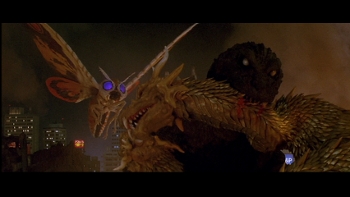
In case you haven’t noticed, GMK left me with many mixed emotions. An eerie ambivalence similar to the feeling one gets eating processed cheese. I see a lot of good in this film (particularly in the integration of CGI special effects – Godzilla’s atomic breath, for example, looks the way it always should have) and a lot that I’ve seen a bazillion times before. Maybe you’re one of those odd people who prefers watching more of the Same Thing but the few new bits here (like the palpable fear displayed by extras, crowds, and Defense Ministry officials at the thought of Godzilla’s return) are welcomed for their rarity, as much as their freshness. They shine like diamonds buried in overly melodramatic crap.
Enjoy it then. I did, and will again quite soon. But I’m still holding my breath, waiting for some ballsy director to bring Godzilla into the twenty-first century. I’m getting a little tired of watching Toho repeat itself.
![]()
![]()
![]()

As I understand it, Kaneko had originally wanted to use Angurus and Varan and Toho insisted on using Mothra and Ghidorah instead. Having Ghidorah as a hero is much harder to assimilate than Godzilla as the villain.
I know, right? And the idea of casting Angurus, Varan, and Baragon as a kind of Trinary Gamera has Kaneko written all over it. Man loves the number three, and obviously gives enough of a shit about the relationship between monsters and Savior/Deity figures. And who would you rather use to play around with this idea? Okay, maybe now we’d say “Gamera,” but back in the early 90s he was a joke with a side of snide comments and fries. Who knows what a Kaneko unfettered by stupid ideas from above could’ve done with Godzilla’s reputation? Missed opportunities all around, this…a handy summing up of the entire post-Millennium series, really.
I really like this movie. I don’t think it returns G to his villanous roots, I think it pushes PAST those roots and makes G not just villanous, but flat-out EVIL. Original G was a villian as a natural disaster is a villian or a wild animal on the loose is a villain: Not malicious, just deadly. In GMK, though, Godzilla is evil as a mass-murderer is evil. He murders on purpose. I don’t think I’d want him to be like that in every G movie, but as something different, it hits the spot!
And making his eyes all-white was a perfect touch, wasn’t it?
I also dug that Mothra isn’t the sweetheart of old, either. Sweetheart or not, a creature THAT big is gonna cause casualities, so it’s nice to see that in this movie, she does. And with her being thus toughened, there’s no reason for the Twin Fairies to be there, so they are rightfully not. Good stuff!
But everything involving the human characters in this movie sucks the farts out of dead cat’s asses. Wise man who acts like he expects things like Godzilla to happen, perky journalist, scientist who doesn’t DO anything…..they’re all here, and they all sniff elbows.
I tend to prefer a villain with irises, myself, but the SokogekiGoji suit did mark the return of some of my favorite G-design elements: the bone-white dorsals, the more feline head, the overall charcoal black color scheme. Combining the ’54 suit’s outline with the Heisei Era bulk makes G a little fatter than I’d prefer, but it’s leaps and bounds beyond the MireGoji from G:2000 and its derivatives, which just keep looking uglier as time goes on and, with my luck, will probably wind up being basis for whatever we’ll see in 2014. “Gareth EdwardsGoji,” I suppose someone (meaning probably no one but I) will call it.